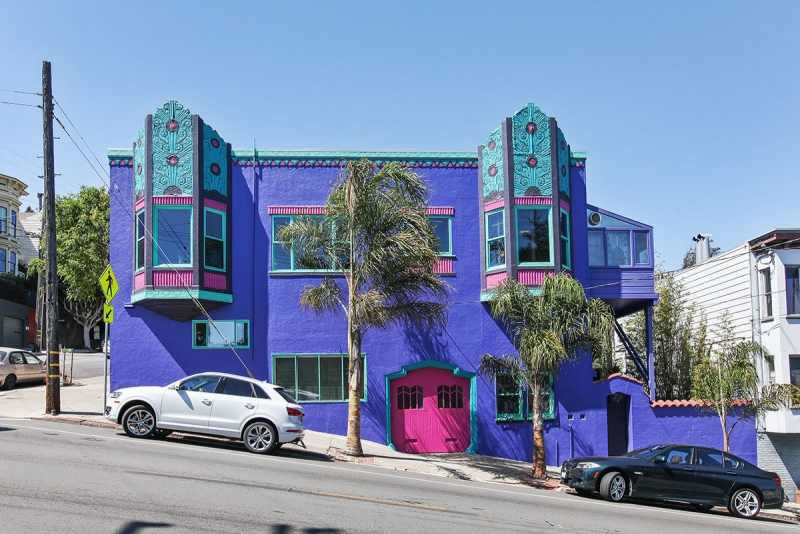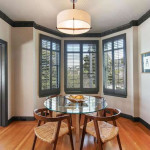Purchased for $1,832,099 in 2012 and listed for $2,850,000 two weeks ago, the sale of the ornate Art Deco home at 99 Ord has already closed escrow with a reported contract price of $3,200,000 or $1,122 per square foot.
The ‘Taravellier House’ was designed by Fabre & Hildebrand and built in 1932. The zebrawood kitchen was added in 2008 following the 2,850-square-foot home’s sale for $1,450,000.














Da*m! So homes are still going for psychotic prices in SF.
We looked at this place last time around (we had recently bought our place not too far away). It’s pretty big, and the kids loved the garage which is the size of a gymnasium, but the layout was terrible. Only two bedrooms (so it wouldn’t work for us) with a third as an in-law off the garage. And the upper level porch seemed a bit seismically suspect. I suppose it could work for someone with just one kid or no kids. The in-law could fetch $2000 at least.
But this selling price is really out there. Convinces me we are into frothy territory that makes no sense. I don’t really care (in fact, I am delighted by it – really, I should sell and retire). But I sure wouldn’t buy in this market unless I had plenty of money to cushion a big drop. Not predicting that will happen, but there is a sizable risk of it. Kudos to the 2012 buyers – well done as that was just before things started to accelerate.
Not sure if you inspected the entire house for seismic stability, but I’m betting it needs some serious work in that department, not just the little add-on porch: foundation reinforcements, shear slabs, shear walls, tie downs, and/or steel moment frames.
So many homes in SF will suffer serious damage without this kind of upgrade. Sadly, most homeowners are wowed by the staging, the colors, the realtor-speak and nothing of substance.
this property had thorough disclosures, Futurist
Sure, buyers will ignore all the problems you listed because of “realtor-speak”.
You are so out of touch some time it’s simply mind-boggling.
Still, no one has mentioned anything about the disclosures pertaining to serious structural issues. To the point about “realtor-speak”, almost every open house I attend the realtor there does NOT know about structural issues, mechanical issues and even code violations, permits etc.
Disclosure or not, many are not informed, but are eager to show off the glam, the finishes, the colors, the fluffed pillows.
It is almost as if the agent is trying to sell the house and it’s pluses and not scare people off discussing real or imagined structural issues that they don’t have the credentials to speak about. Weird.
The moral is never depend on a RE agent (on either side of the transaction) for information on the condition of the property. Do your own assessment or hire someone who can.
A good agent will be honest about things like this – with both sides. Before we bought, the seller’s agent walked us around and carefully pointed out everything that was going to require some work (nothing really serious, but about $10,000 total). It was greatly appreciated, and it was an irrelevant fraction of the price so it had no impact on the deal. That is how you develop a good reputation as an honest intermediary and get referrals. Of course, the good agents are vastly outnumbered by the not-so-good ones. We bought when buyers were few and far between, and I’m guessing it is easier now to get away with hiding the flaws as no-conditions sales are so common in this market.
I agree with the advice to bring along your own inspector.
that was mentioned, actually. the term used was thorough. you are making an assumption and casting aspersions based upon an assumption. it’s normal for you to behave that way and people know that you’re full of nonsense when it comes to numerous issues. that doesn’t make what you say fair, but at least people know by now.
I’ll stand by my comments. Fact is most buyers will ooh and ahh over the Zebrawood kitchen and the art deco details, but will not think about the fixes and costs necessary to upgrade the house for seismic safety. Its a risky investment when you choose to spend $3.2 m and not spend a little more to add some structural rigidity to the property.
Adding seismic components that I previously mentioned would only cost in the range of $75-100k.
Futurist, really, is it a “fact”? Then I supposed you’ve got some hard data and/or evidence to back up this “fact” with?
Stick to architecture. You’re waaaaaaaaaaaaaaay out of your depth on this one. Any buyer’s agent who submits an offer on behalf of their client without a thorough review of the disclosures and a comprehensive property inspection (which would illuminate the issues you described) shouldn’t be in the business – and I have a hard time believing that would happen at this price point.
But I guess you know better with your cadre of “facts”, right?
Well there are facts and then there are futurist-facts. 🙂 But there is something to his assertion that buyers will gloss over the boring and difficult to ascertain details of the robustness of the structure as well as the soundness of the ground it is built upon and instead be distracted by shiny things.
Many buyer’s agents are good at looking out for the buyer and making sure that they know the true state of the property. Those people are golden. But there are some who willfully gloss over the warts and expect the buyer to thumb through a one inch stack of disclosures on their own to figure out what’s important and what is not. You know, the sort of agent who drives their
markclient to the property via a circuitous route avoiding passing the nearby ramshackle housing projects and scrap metal collectors. To show the property in its best light of course.I once was pressured toward putting an offer on a house because we had been looking for a while (I’m sooo picky) and it met my criteria of being in the right neighborhood (just barely, right on the edge), was sited on a large parcel (because you can measure a steep embankment at a diagonal), and fit my price constraints (maybe because it was nearly worthless). I was concerned about the stability of the embankment because most of the house was supported on posts extending to piers set in the embankment. Agent said I’d lose the deal if I got a geological engineer involved to assess the stability of the slope. So I lost the deal and the agent.
That house no longer exists. Not sure what happened to it but nothing has been rebuilt on the site for over fifteen years.
Essentially I agree with you on this one MOD: that’s what I’m attempting to say; even the buyers agent can and often does gloss over the important issues of a house only to steer the potential buyer toward the upgraded kitchen full of Sub-zero, Miele and Bosch, while the house is sitting on a brick foundation. They may “mention” the brick foundation, but often (more often than not) will vastly underestimate the cost and complexity of replacing that foundation.
I have often been engaged by potential buyers to do a walk-thru with them on a property and when I am introduced as the architect, the selling agent gets very nervous, (sometimes hostile) when I ask some pointed questions about structure, systems, permitted spaces, etc.
I’m not there to make friends with the selling agent. I’m there to help my client make good decisions. And that’s really what my original comments were addressing.
your comments have nothing to do with this property
My comments can equally apply to any and every residential property up for discussion on SS.
I want to ignore this back and forth argument for a moment and say that old SF houses with lovingly applied fancy finishes and everything very original always raise a big red flag.
This is because I have lived in SF since 1979 and that time period includes a big chunk of time where a house like this was worth 10% of what it just sold for.
People who were into it, gay people, the hippies that stayed, the “Gift to the Street” Victorian restoration generation could scrape together the money to gold leaf the ceiling but they would never even think about the foundation. I know houses where the owner, or even a long term renter, stripped every piece of interior trim in place and refinished it to a level of quality that is very difficult to pay any amount for – but they didn’t touch the electrical system, except to find some more matching 100 year old push button switches.
“My comments can equally apply to any and every residential property up for discussion on SS”
no they can’t as you did not read these disclosures. really futurist. odd stuff
It was the disclosures (at least those in 2012) that raised my eyebrows about the upper level porch. Don’t know about the foundation or anything else here as we were just there to have a look around. But of the places we seriously considered when in the market, our inspector raised concerns about the foundations of 3 out of 4 (and we bought that 4th one). Nothing in the disclosures of any of these places mentioned any issues, which is not necessarily “wrong” as you only need to disclose what is known, giving sellers an incentive to become willfully blind. Based on this limited sample, I would agree that this is something that should be closely inspected by anyone in the market to buy.
I assume that many of these all cash offers that close in 2 weeks have no contingencies, including inspection contingencies. Does anyone know if the buyers generally have inspections beforehand or they just rely on disclosure statements?
@ JR Bob dobbs: Thanks for your comment. You have only reinforced what I have been saying (and apparently upsetting a number of people).
Fact is that disclosures often do NOT go into detail with regard to possible negative issue of the property. Yes, the sellers CAN be “willfully blind”. And that also means the selling broker can play the same blind game.
Again, as I have said: the selling broker is there to sell you the fluff, the glam, the views, the colors, all the “pretty stuff”, and nothing more.
Rely on your licensed and qualified inspector for the heavy stuff. As a buyer, they should be asking the tough questions to the selling agent even during the walk thru.
And that’s exactly what I’ve been saying all along.
oh, like the licensed and qualified contractor who in an inspection disclosure, clearly laid out all the issues he detected after spending several hours inspecting this property? once again, your generalizations + assumptions are not worthwhile things. Now you are assuming that people can’t understand disclosures? why?
I would submit that the top pre-sale inspection companies who are routinely hired to list items that may effect the property, safety, seismic, and otherwise, know far more about these issues than architects.
The buyer’s ability to understand disclosures varies. I’ve found them to contain a few nuggets of important information wrapped up on tons of useless boilerplate. Even though I feel better equipped than the average buyer when assessing the state of a building I find analyzing a disclosure pack daunting. And not all building inspectors will catch all problems. They’re just human and if seeing the symptoms(*) of a problem is hard then they might not make the effort to dig deeper.
(*) which is one of the reasons that stagers often paint odd places like basements. Paint is a cheap and effective way to cover up symptoms of chronic moisture infiltration.
In 2012, was it foreclosed upon? That is a really odd final closing price.
3.2m — wow!
This is stepping beyond the typical techie family income levels. Wondering what type of buyer this could be…
Nearly every property featured here is “beyond the typical techie family income levels.” I don’t know what you people think is typical, but it’s certainly less than $500k/year, meaning that even a $2M home is beyond the “typical” techie family income levels (barring a one-time windfall from an IPO, etc.).
$500K/yr is very reasonable for a married tech couple over 40 with 15 yrs experience each.
Sure, if both members are at a VP level which is pretty rare….
Glass door has a pretty good wage data for tech.
250k is pretty typical for a director level . $200K salary; $50K bonus. and thats not including any stock
He didn’t say typical director, but typical techie.
This is, clearly. beyond the typical techie family. He was right.
i guess i assumed the most likely people to have a family are people in their 40s, and those people generally have 15 yrs experience and many would be at director level.
A number of scenarios for the buyers: one-time windfall; trust-funder; high regular incomes as an investment banker, law firm partner, various business owners, surgeons, etc. The only group that has grown is the “one time windfall” group. Thing is, there were a fair number of these other people who could pay $3.2M for a home like this a few years ago but did not do so because you did not need to do so. You could pick it up for $1.8M, or $1.4M. You don’t pay the maximum you canpay for a home. You pay the minimum you need to pay to get it (sometimes those two end up being the same thing – but then you are overextended). That this minimum has shot so high is why I’m thinking we are now firmly in bubble territory. When the “one time windfalls” become less frequent, the bubble deflates.
Love everything about the house, except the exterior. It doesn’t go far enough. Make that trim orange/gold and green! Mardi Gras everyday!!
Love that young tech money.
I bet the buyers are under 40.
Years ago, a noisy street like 17th Street would be a hard sell. Doesn’t seem so at this point but when the market takes a dip at some point, it might be a hard sell again.
You guys are out of date. A senior-level engineer with 10 yrs experience is getting about 300K/yr at Apple with a mid-range bonus, which they have been regularly getting for the past several years (the more sought after folks are closer to the 500K range). This has dragged salaries at most of the top-tier tech companies up to well north of 200K for similar engineers (not everybody gets to work at Apple).
Not sure how Glassdoor and the like get their numbers. My sense is that they are underreported by tech companies who want to try to keep a lid on recent wage inflation (ie by reporting only base salary and not including the huge bonuses that have become an all-but-dependable portion of tech compensation for a number of years now), but if you have friends working at these places who you know well enough to get compensation info from you’ll hear numbers like this. And god help you if you are trying to recruit folks from out of places like Apple.
There are plenty of two-income couples like this who have already had enough of a cash windfall to make the down payment. With the small number of homes that get listed in SF, you can see how they set the prices.
Its the rest of society that is falling behind.
Really? 300K base for senior level engineers I would think is reserved for just a select few MVP’s. Hard to think that is the standard. Crazy.
it is though. so now we learn something, and move on
$3000 a month in property taxes alone! That would crush us mere mortals…
anyway, my family makes about $450K, and we would never buy anything above $1.3M with our salary, which means im very happy im not looking right now:)